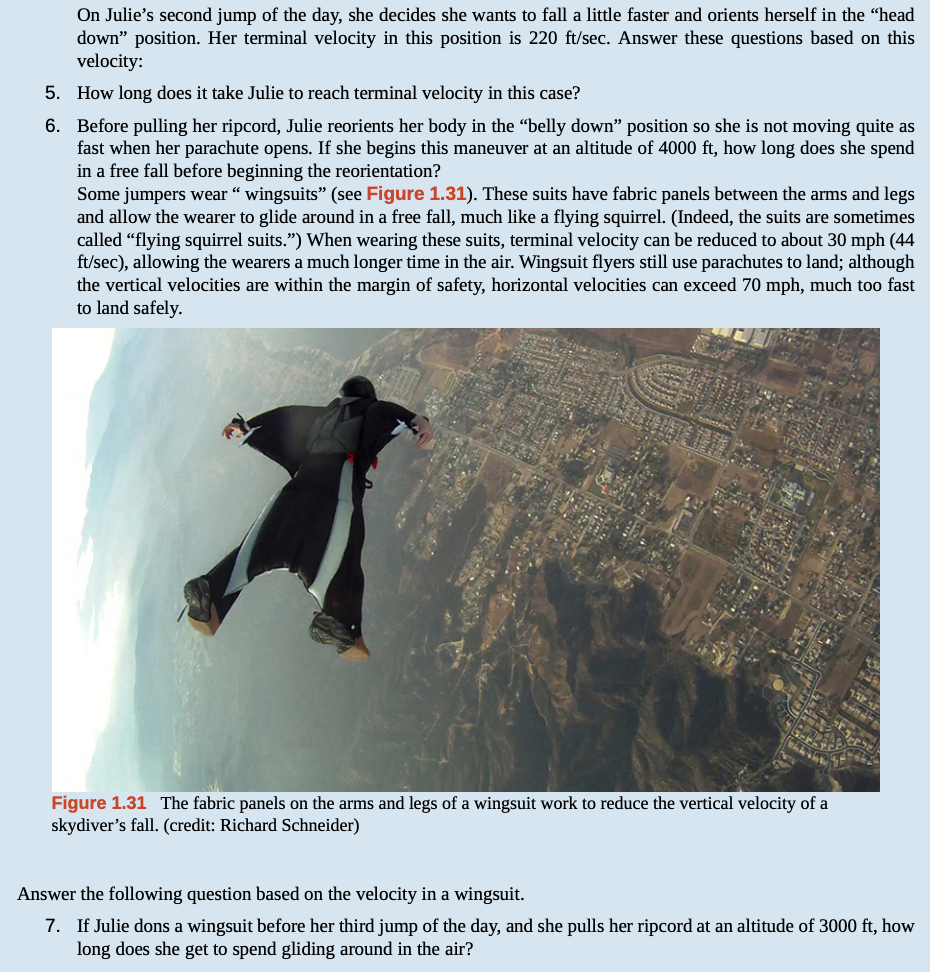Julie is an avid skydiver. She has more than 300 jumps under her belt and has mastered the art of making adjustments to her body position in the air to control how fast she falls. If she arches her back and points her belly toward the ground, she reaches a terminal velocity of approximately 120 mph (176 ft/sec). If, instead, she orients her body with her head straight down, she falls faster, reaching a terminal velocity of 150 mph (220 ft/sec). Since Julie will be moving (falling) in a downward direction, we assume the downward direction is positive to simplify our calculations. Julie executes her jumps from an altitude of 12,500 ft. After she exits the aircraft, she immediately starts falling at a velocity given by v(t) = 32t. She continues to accelerate according to this velocity function until she reaches terminal velocity. After she reaches terminal velocity, her speed remains constant until she pulls her ripcord and slows down to land. On her first jump of the day, Julie orients herself in the slower "belly down" position (terminal velocity is 176 ft/sec). Using this information, answer the following questions.
Julie is an avid skydiver. She has more than 300 jumps under her belt and has mastered the art of making adjustments to her body position in the air to control how fast she falls. If she arches her back and points her belly toward the ground, she reaches a terminal velocity of approximately 120 mph (176 ft/sec). If, instead, she orients her body with her head straight down, she falls faster, reaching a terminal velocity of 150 mph (220 ft/sec). Since Julie will be moving (falling) in a downward direction, we assume the downward direction is positive to simplify our calculations. Julie executes her jumps from an altitude of 12,500 ft. After she exits the aircraft, she immediately starts falling at a velocity given by v(t) = 32t. She continues to accelerate according to this velocity function until she reaches terminal velocity. After she reaches terminal velocity, her speed remains constant until she pulls her ripcord and slows down to land. On her first jump of the day, Julie orients herself in the slower "belly down" position (terminal velocity is 176 ft/sec). Using this information, answer the following questions.
Related questions
Question

Transcribed Image Text:Julie is an avid skydiver. She has more than 300 jumps under her belt and has mastered the art of making adjustments
to her body position in the air to control how fast she falls. If she arches her back and points her belly toward the
ground, she reaches a terminal velocity of approximately 120 mph (176 ft/sec). If, instead, she orients her body with
her head straight down, she falls faster, reaching a terminal velocity of 150 mph (220 ft/sec).
Since Julie will be moving (falling) in a downward direction, we assume the downward direction is positive to simplify
our calculations. Julie executes her jumps from an altitude of 12,500 ft. After she exits the aircraft, she immediately
starts falling at a velocity given by v(t) = 32t. She continues to accelerate according to this velocity function until she
reaches terminal velocity. After she reaches terminal velocity, her speed remains constant until she pulls her ripcord
and slows down to land.
On her first jump of the day, Julie orients herself in the slower “belly doWn" position (terminal velocity is 176 ft/sec).
Using this information, answer the following questions.

Transcribed Image Text:On Julie's second jump of the day, she decides she wants to fall a little faster and orients herself in the "head
down" position. Her terminal velocity in this position is 220 ft/sec. Answer these questions based on this
velocity:
5. How long does it take Julie to reach terminal velocity in this case?
6. Before pulling her ripcord, Julie reorients her body in the "belly down" position so she is not moving quite as
fast when her parachute opens. If she begins this maneuver at an altitude of 4000 ft, how long does she spend
in a free fall before beginning the reorientation?
Some jumpers wear “ wingsuits" (see Figure 1.31). These suits have fabric panels between the arms and legs
and allow the wearer to glide around in a free fall, much like a flying squirrel. (Indeed, the suits are sometimes
called “flying squirrel suits.") When wearing these suits, terminal velocity can be reduced to about 30 mph (44
ft/sec), allowing the wearers a much longer time in the air. Wingsuit flyers still use parachutes to land; although
the vertical velocities are within the margin of safety, horizontal velocities can exceed 70 mph, much too fast
to land safely.
Figure 1.31 The fabric panels on the arms and legs of a wingsuit work to reduce the vertical velocity of a
skydiver's fall. (credit: Richard Schneider)
Answer the following question based on the velocity in a wingsuit.
7. If Julie dons a wingsuit before her third jump of the day, and she pulls her ripcord at an altitude of 3000 ft, how
long does she get to spend gliding around in the air?
Expert Solution
This question has been solved!
Explore an expertly crafted, step-by-step solution for a thorough understanding of key concepts.
This is a popular solution!
Trending now
This is a popular solution!
Step by step
Solved in 4 steps
